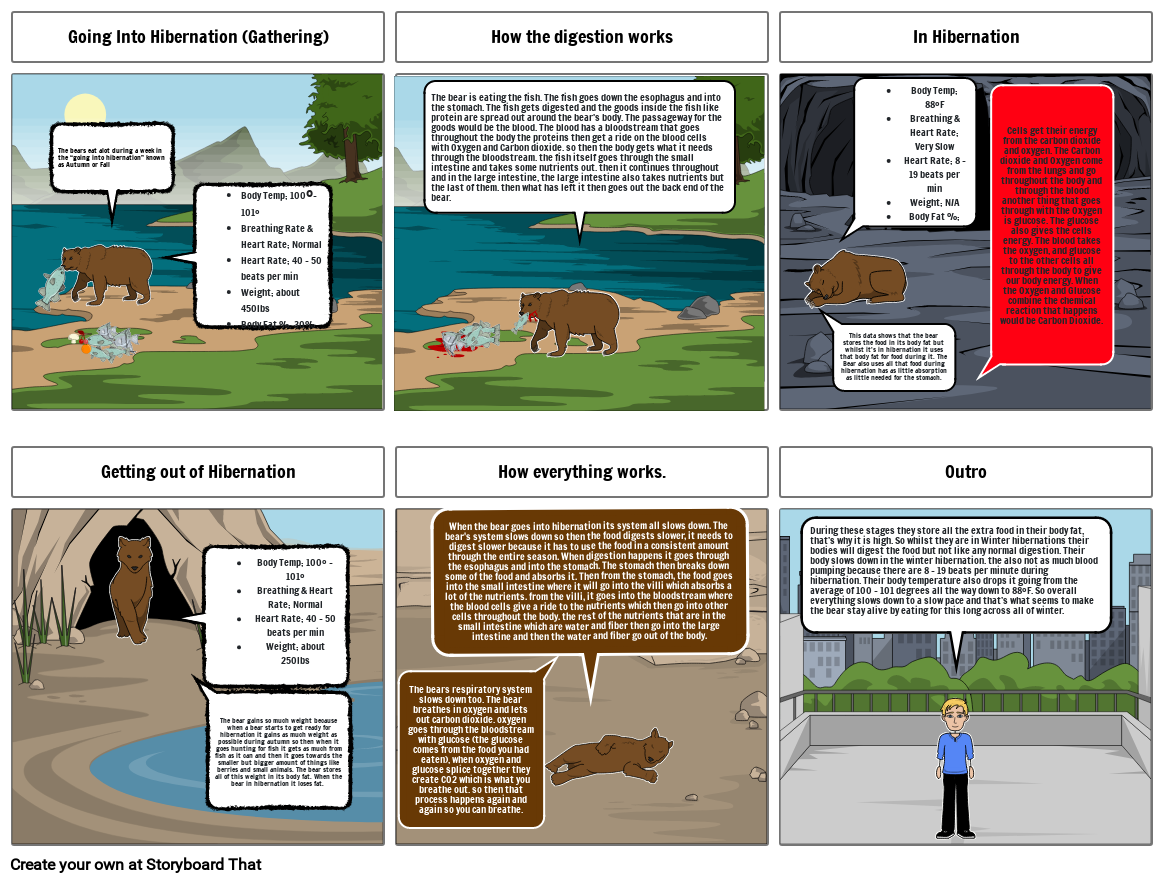Science - Bear Hibernation

Texto del Guión Gráfico
- Going Into Hibernation (Gathering)
- The bears eat alot during a week in the “going into hibernation” known as Autumn or Fall
- Body Temp; 100°- 101°Breathing Rate & Heart Rate; NormalHeart Rate; 40 - 50 beats per minWeight; about 450lbsBody Fat %; 30%
- How the digestion works
- The bear is eating the fish. The fish goes down the esophagus and into the stomach. The fish gets digested and the goods inside the fish like protein are spread out around the bear's body. The passageway for the goods would be the blood. The blood has a bloodstream that goes throughout the body the proteins then get a ride on the blood cells with Oxygen and Carbon dioxide. so then the body gets what it needs through the bloodstream. the fish itself goes through the small intestine and takes some nutrients out. then it continues throughout and in the large intestine, the large intestine also takes nutrients but the last of them. then what has left it then goes out the back end of the bear.
- In Hibernation
- This data shows that the bear stores the food in its body fat but whilst it’s in hibernation it uses that body fat for food during it. The Bear also uses all that food during hibernation has as little absorption as little needed for the stomach.
- Body Temp; 88°FBreathing & Heart Rate; Very SlowHeart Rate; 8 - 19 beats per minWeight; N/ABody Fat %; N/A
- Cells get their energy from the carbon dioxide and oxygen. The Carbon dioxide and Oxygen come from the lungs and go throughout the body and through the blood another thing that goes through with the Oxygen is glucose. The glucose also gives the cells energy. The blood takes the oxygen, and glucose to the other cells all through the body to give our body energy. When the Oxygen and Glucose combine the chemical reaction that happens would be Carbon Dioxide.
- Getting out of Hibernation
- Body Temp; 100° - 101° Breathing & Heart Rate; NormalHeart Rate; 40 - 50 beats per minWeight; about 250lbs
- The bear gains so much weight because when a bear starts to get ready for hibernation it gains as much weight as possible during autumn so then when it goes hunting for fish it gets as much from fish as it can and then it goes towards the smaller but bigger amount of things like berries and small animals. The bear stores all of this weight in its body fat. When the bear in hibernation it loses fat.
- How everything works.
- The bears respiratory system slows down too. The bear breathes in oxygen and lets out carbon dioxide. oxygen goes through the bloodstream with glucose (the glucose comes from the food you had eaten), when oxygen and glucose splice together they create CO2 which is what you breathe out. so then that process happens again and again so you can breathe.
- When the bear goes into hibernation its system all slows down. The bear's system slows down so then the food digests slower, it needs to digest slower because it has to use the food in a consistent amount through the entire season. When digestion happens it goes through the esophagus and into the stomach. The stomach then breaks down some of the food and absorbs it. Then from the stomach, the food goes into the small intestine where it will go into the villi which absorbs a lot of the nutrients. from the villi, it goes into the bloodstream where the blood cells give a ride to the nutrients which then go into other cells throughout the body. the rest of the nutrients that are in the small intestine which are water and fiber then go into the large intestine and then the water and fiber go out of the body.
- Outro
- During these stages they store all the extra food in their body fat, that’s why it is high. So whilst they are in Winter hibernations their bodies will digest the food but not like any normal digestion. Their body slows down in the winter hibernation. the also not as much blood pumping because there are 8 - 19 beats per minute during hibernation. Their body temperature also drops it going from the average of 100 - 101 degrees all the way down to 88°F. So overall everything slows down to a slow pace and that’s what seems to make the bear stay alive by eating for this long across all of winter.
Más de 30 millones de guiones gráficos creados

